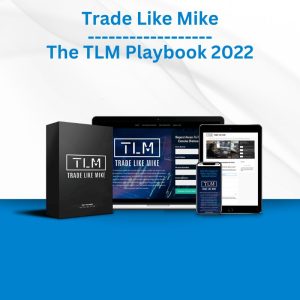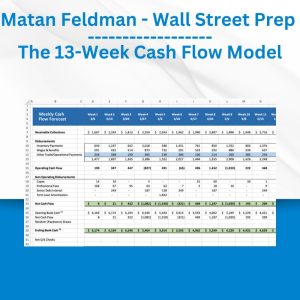*** Proof of Product ***
Exploring the Essential Features of “Budgeting and Forecasting – Tim Vipond – CFI Educatio”
This budgeting course covers the entire budgeting process from start to finish, including various methods for building budgets and forecasting results.
- Learn how to create a “budgeting culture” in your organization
- Analyze variances between budget and actual results
- Identify key areas to help improve your organization’s financial results
Overview
Recommended Prep Courses
These preparatory courses are optional, but we recommend you to complete the stated prep course(s) or possess the equivalent knowledge prior to enrolling in this course:
- Accounting Fundamentals
- Excel Crash Course
Financial budgeting course description
This financial budgeting course will teach you about the entire budgeting process from start to finish, including how to create a disciplined culture of budgeting in your organization, the various methods for building budgets, techniques to analyze results, and how to increase the chances of organizational performance improvements.
This interactive and applied budgeting course enables participants to:
- Adopt a disciplined approach to developing budgets
- Forecast results with quantitative and qualitative methods
- Effectively use variance analysis to track performance
- Present results with charts and graphs
Who should take this budgeting class?
This online budgeting class is designed for those who are responsible for financial management, budgeting, and forecasting within their organizations. This may include professionals working in financial planning and analysis (FP&A), accounting, treasury, financial reporting, corporate development, etc.
What you will learn in this budgeting 101 course
By the end of this budgeting 101 class, participants are able to:
- Understand the principles behind best practice financial management
- Explain the importance of budgeting within a strategic framework
- Build a robust budgeting process within their organization
- Know when and where to use various budgeting approaches such as zero-based budgeting
- Forecast future performance by better analyzing revenue and cost drivers
- Use effective variance reporting to track organizational performance
- Make use of Excel functions and tools that are particularly suited to the budgeting process.
Financial budgeting class content
Topics covered will include:
- Budgeting within a strategic framework
- Building a robust budgeting process
- Managing budget psychology
- A practical guide to developing budgets
- Common budgeting approaches (e.g. Incremental, value-based, zero-based, etc.)
- Forecasting techniques (moving average, regression analysis, etc.)
- Tracking budget performance with variance analysis (waterfall charts, etc.)
- Applied budgeting tools and techniques (Excel, solver, pivot tables, etc.)
What you’ll learn
Introduction
Course introduction
Course learning objectives
Instructors
Download course presentation
Budgeting Within a Strategic Framework
Learning objectives
Barriers to strategy execution
Translating the strategy into a business plan
Interactive exercise 1
Balanced scorecards
Top reasons to budget
What to watch out for
Interactive exercise 2
Building a Robust Budgeting Process
Learning objectives
The master budget
3 categories of budgets
Interactive exercise 3
Manufacturing company example
Retail company example
Services company example
Where to start with budgeting
Steps in the budgeting process
Psychology and target setting
Top down vs. bottom up involvement
Interactive exercise 4
A Practical Guide to Developing Budgets
Learning objectives
4 approaches to budgeting
Incremental budgeting
Activity based budgeting
Value proposition budgeting
Zero based budgeting
Interactive exercise 5
Beyond budgeting
Forecasting Techniques
Learning objectives
Cost types
Modified cost types
Cost structure and earnings volatility
Cost structure exercise template
Cost analysis demonstration
Breakeven analysis and margin of safety demonstration
Sensitivity analysis with data table
Interactive exercise 6
Cost control matrix
Quantitative forecasting methods
Forecasting exercise template
Moving averages
Simple linear regression
Excel FORECAST function
Equation of a line regression
Multiple linear regression overview
Multiple regression Excel demonstration
Interpreting regression summary output
Using the multiple regression equation
Interactive exercise 7
PEST analysis
Porter’s 5 forces
Tracking Budget Performance with Variance Analysis
Learning objectives
What is variance analysis
Volume vs. price variance
Cost variance
Interactive exercise 8
Variance analysis exercise template
Variance analysis in Excel
Variance impact and waterfall chart data
Variance waterfall chart in Excel
Variance waterfall chart template
Root cause analysis
Presenting results of variance analysis
Interactive exercise 9
Applied Budgeting Tools and Techniques in Excel
Learning objectives
Budgeting tools exercise templates
Goal Seek tool in Excel
Solver tool in Excel
Consolidate function in Excel
Pivot tables overview
Setting up a pivot table in Excel
Beyond Excel
Interactive exercise 10
Conclusion
Conclusion and recap of objectives
Download appendices and bonus templates
Appendix models
Summary
Qualified Assessment
Qualified assessment
Please see the full list of alternative group-buy courses available here: https://lunacourse.com/shop/










 The Daily Traders – Exclusive Trading Mentorship Group
The Daily Traders – Exclusive Trading Mentorship Group